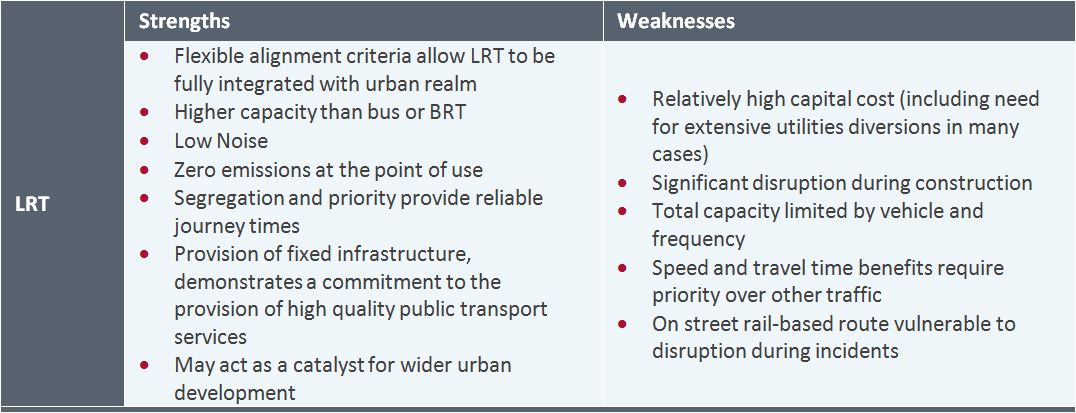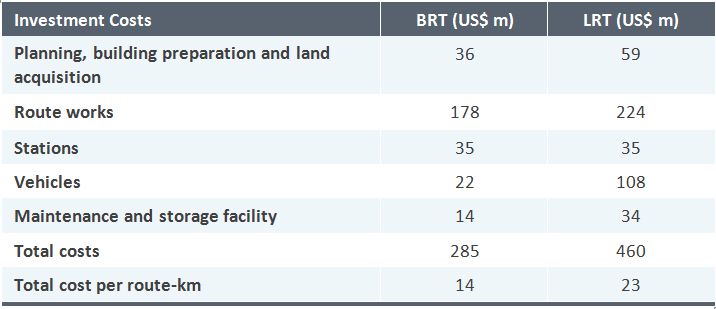As worldwide urban populations grow and cities become more densely populated, the demand for rapid transport systems also grows. A well-integrated rapid transport system is the aspirational goal for any city authority seeking to move its citizens from A to B in a fast, efficient and comfortable way.
Light Rail Transit (LRT) is often seen as the superior sibling to Bus Rapid Transit (BRT). It is, however, important to consider each case individually. In this article, we will investigate the strengths and weaknesses of both options from construction, operation and end-user perspectives.
What is rapid transit?
Rapid transit describes transport technology and systems targeted at densely populated urban areas to provide higher levels of passenger capacity than standard bus services, along with faster and more reliable journey times. The capacity and journey time benefits are achieved by a combination of the use of high capacity vehicles, increased service frequency, and high levels of priority and segregation over other modes, particularly general traffic.
Strengths and weaknesses of LRT and BRT
At this stage, the attributes of BRT and LRT are quite well aligned, as long as the adequate segregation is provided for the BRT. However, LRT can generally offer more capacity, presumably making it the preferred option.
So, let's delve a little deeper.
Investment costs for developing a rapid transit system
Investment costs are the upfront cost required for development, including the cost of rolling stock and the construction of the line. The costs below are based on the following assumptions:
- 145 seat vehicles
- Two lines with total length of 20km
- Five-minute service frequency
- 20km/h trip speed
- 3000 route circulations per year with 32 vehicles
- System running on right-of-way track
Operating costs for developing a rapid transit system
Operating costs cover the cost of running the vehicles. The costs below are based on the following assumptions:
- Annual mileage of 60,000 km
- 3500 hrs of annual operation
- $37.8/hr driver cost
- Interest rate of 3%
- 145 passenger capacity
As is shown from this assessment, significant cost saving can be made by opting for BRT over LRT. This stage of the appraisal would conclude that BRT is the preferred option.
End-user experience
It is very useful to compare LRT and BRT in terms of its attributes, such as high service frequency or high quality rolling stock. It is also useful to compare costs in order to gauge the long and short term affordability of the service, making an assessment of end-user experience very valuable.
Steer Davies Gleave carried out a study to compare the end-user experiences of BRT and LRT in the unique French city of Nantes. Nantes has a small BRT system and a more extensive LRT system. It is the optimal place to compare the two-rival systems. The results gave an interesting insight into the question of what a user prefers: BRT or LRT?
The five-point scale of service attributes
515 regular users of the BRT and the LRT were asked to grade their experience of a wide range of attributes. The results of this study are shown in the table below. Since the BRT is newer, it performed better in terms of user experience of the vehicle. The LRT has more regular services and has interchanges between lines and was, therefore, judged to have better service levels.
Do people prefer BRT or LRT?
It is often claimed that people prefer LRT to BRT because it is intrinsically ‘better’. In Nantes it was possible to test this by measuring people’s preferences after allowing for the effects of different network coverage and the newness of the BRT vehicles.
This was done using Stated Preference, a specialised market research technique in which people are asked to choose between carefully designed alternatives with varying fares. This allows their strength of preference to be measured on a monetary scale, so that comparisons can be made.
The overall finding was that there was a preference for LRT over BRT, to a value of eight cents per one-way trip. This is consistent with the overall rating scale. In addition two further factors were monetised:
- LRT comfort was poorer than BRT comfort to the value of €0.08 per trip
- LRT service levels were better than BRT service levels to the value of €0.28 per trip
Using this information it is possible to deduce that if the BRT’s service network was as extensive as the LRT’s, overall preference for LRT would reduce from €0.08 per trip to €0.08 minus €0.28. This means a “preference” for LRT over BRT of -€0.20. The negative indicates BRT is now the preferred mode.
If it was then possible to improve the overall comfort levels on the LRT to the level of the BRT, this would improve the preference for LRT from -€0.20 to -€0.20 plus €0.08 or -€0.12. The sign is still negative, meaning the BRT is still preferred, albeit by a smaller sum.
What to conclude from the survey?
These findings are specific to Nantes, deriving from the services implemented there and the views of the local population and their attitudes towards public transport. In detail, the survey results may not be transferable elsewhere. However, we can draw an important conclusion from the survey and the conventional comparison: BRT is not necessarily inferior to LRT. On the contrary, this research shows that a well-designed and operated BRT system can be at least as attractive to passengers as LRT, if not more.
Find out more about our research in Nantes


